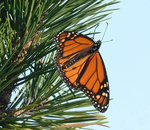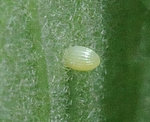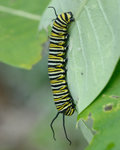, 0°
Wind: mph
The plight of the monarch butterfly has been well known for many years. The butterflies have lost their wintering forested habitat due to timber harvesting in Mexico, and lost their milkweed habitat …
Stay informed about your community and support local independent journalism.
Subscribe to The River Reporter today. click here
This item is available in full to subscribers.
Please log in to continue |



The plight of the monarch butterfly has been well known for many years. The butterflies have lost their wintering forested habitat due to timber harvesting in Mexico, and lost their milkweed habitat because of several factors in the U.S.
For the last several years, winter counts of this species have been performed by the Center for Biological Diversity In a press release dated May 24 of this year, it says this about this past winter’s count: “The yearly count released today of monarch butterflies that overwintered in Mexico continues to show imperilment for the migratory butterfly. This year’s count of 2.84 hectares (7 acres) of occupied winter habitat is up slightly from last year, but still below the 6-hectare threshold scientists say is necessary for the iconic pollinator to be out of the extinction danger zone in North America.”
I have seen some flying monarchs and a few caterpillars this summer; these are anecdotal observations, though, as weather patterns and other events can affect the numbers seen in a given year at specific locations. There was a time several years ago where I saw no larvae and only a few flying adults near the end of summer; they were likely on their migration trip.
In a press release dated 21 July of this year, the IUCN (International Union for Conservation) has declared the migrating monarch butterfly as endangered. The press release states in part, “The migratory monarch butterfly (Danaus plexippus plexippus), known for its spectacular annual journey of up to 4,000 kilometres across the Americas, has entered the IUCN Red List of Threatened Species as Endangered, threatened by habitat destruction and climate change.”
Of note is the scientific name cited in this press release; the migrating monarch butterfly (Danaus plexippus plexippus) is a subspecies of the monarch butterfly (Danaus plexippus), which is non-migrating. The non-migrating variant occurs in Central and South America; the climate is such in some tropical areas that the monarchs have no need to migrate. More can be read here: https://www.thoughtco.com/monarch-butterfly-migration-1968018
Because the IUCN is not a governmental regulatory agency of any state or nation, it yields no powers in rule-making in order to protect species on its list. It does, however, raise further awareness of the plight of this species.
Locally, we can help preserve milkweed habitat; milkweed is critical for the monarch’s survival. Two of the three images in this week’s column were captured at roadside locations in upland areas in mostly forest habitat. If you live on a road where the plant is growing, consider not cutting or spraying where milkweed is present.
Comments
No comments on this item Please log in to comment by clicking here